Gulek → German.
| Gulek |
| Inventor: Dr. Michael Günter Friedrich Winkelmann, 1987 |
| Ranks: Circular |
| Sowing: Single laps |
| Region: Austria |
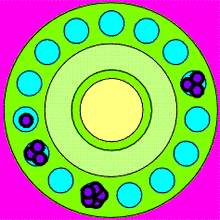
Gulek Board
Gulek (from Gu = (short for:) "Gumpoldskirchen" + lek = (Swedish:) "game") was invented by the Austrian math teacher and game designer Michael Winkelmann in 1987, when he lived in Gumpoldskirchen (hence its name). The game was awarded the first prize of the design contest at the 3rd Austrian Game Festival in Vienna in 1987. Gulek was published by the Vock'sche Werkstatt in 1990. The game is an unusual mancala-variant for 2-6 players.
Michael Winkelmann also designed Myra (1955) and Esiema (1989).
Rules
The game board consists of 15 pits, a big hole in the center, and a circular furrow in between. Each player has 20 balls of his color.
First Stage
At the beginning, players take turns putting one of their balls into a pit. It doesn't matter whether this pit is already occupied by another ball or not. The first stage ends, when all balls have been distributed.
Moving in the Second Stage
On his turn a player sows the contents of a pit, one by one, into the ensuing pits (either clockwise or counterclockwise). It is only permitted to choose a pit, which contains at least two balls, one of which must have the player's color. Singletons cannot be moved. The last ball distributed in a turn must always be a ball of the player's color.
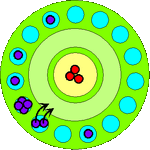
Parking (example)
At the end of his turn a player may remove any pairs of his own balls, if a pit contains only just one pair and no other balls. This is called protecting ("Sichern") or parking ("Parken"). The pairs are stored in the circular furrow. Later a player may place any number of these pairs into an empty pit instead of making a proper move.
Player must move if possible, else pass.
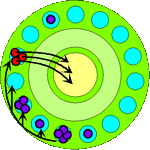
Capturing (example)
Captures
Balls of the opponent, which are in the last pit of a sowing, are captured. They are removed from the play by putting them into the big hole in the center.
Goal
The game ends, when neither player can move.
The player with the most balls on the board wins. The game is a draw, when no ball was captured in the last five moves.
Variations
Shorter Game
The game can be shortened as follows:
- A player loses, when he can't move.
- In the first stage, two balls are placed on the board each turn.
Gulek Solo
Gulek Solo is a solitaire game. At the start there are four balls in each of the 15 pits, colors don't matter.
Game Play:
On his turn a player empties the contents of any pit he wants and then distributes the balls either clockwise or counterclockwise one by one into the succeeding pits. The move ends, when the last ball was dropped. A singleton cannot move. If, after the move, there are two balls in a pit, these can be removed, but they can also be kept there. After that the contents of another pit is distributed. The object of the game is to remove all the balls from the board.
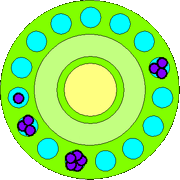
Gulek Solo
Variant 1: The two balls must be removed.
Variant 2: The last ball in hand cannot be dropped into an empty pit.
Variant 3: Rules of variant 1 and 2 are combined.
The left position (3, 1) can only be solved in the simple variant. The other position (5, 3) can be solved in every variant.
Gulek Single
Gulek Single is also a solitaire game. Again there are four balls in each of the 15 pits initially. Colors don't matter either.
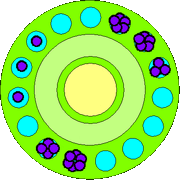
Winning Position in Gulek Single
Game Play:
The rules are similar to Gulek Solo except that the last ball in hand starts another lap, if it falls into an occupied pit, while the direction (clockwise or counterclockwise) must be kept the same. The move ends, when the last ball is dropped into an empty pit or a pit containing a singleton.
Variant: Two balls must be removed.
Copyright
Translated and adapted from the German Spielwiki article on "Gulek", http://unknowns.de/wiki/index.php?title=Gulek, under the GNU Free Documentation License. The list of authors is available on this page.